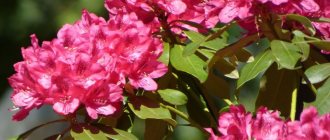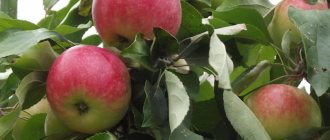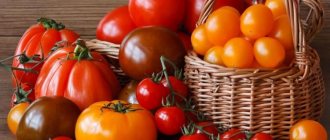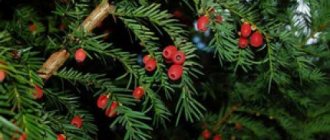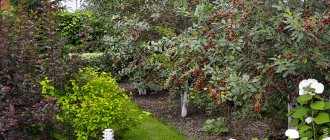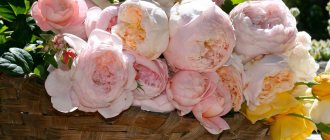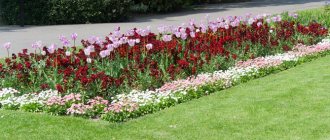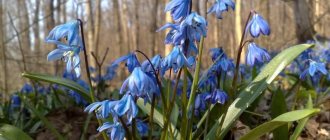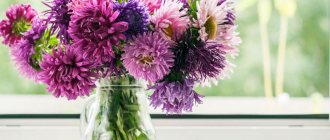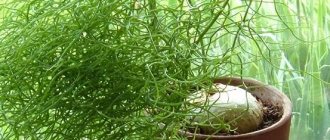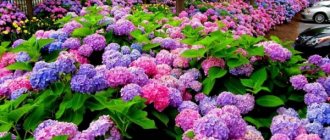What types of shrubs are there?
All plants are divided into two large categories:
- Conifers . This group includes evergreen trees and shrubs that have needles instead of leaves. Their main difference is their undemandingness to environmental conditions. In the wild, plants develop in the mountains, often in the taiga, where there is little moisture and light. Junipers, thujas, and cryptomerias have adapted to accumulate resources in order to survive in the harshest conditions.
- Deciduous . This includes ornamental and fruit shrubs. In gardens and country groves, barberry, lilac, viburnum, and raspberries are often found.
Wild shrub plants for the garden
It is necessary to choose shrubs taking into account the climate and characteristics of the site. To keep your garden well-groomed, give preference to plants that retain foliage throughout the spring and summer. Some species, such as conifers, look bright and attractive throughout the year.
Rules for choosing wild shrubs and creating a composition from them:
- Plants look good alone or in a group. In the second case, it is better to plant 3-4 ornamental bushes nearby, for example: viburnum + honeysuckle + chokeberry + rose hips.
- If the terrain allows, plant lush, spreading trees; for small and medium-sized areas, miniature crops that can take any shape are suitable. As a rule, such plants do not require frequent pruning.
- Use evergreen trees to create a background; use variegated, yellow, and red trees to create accents.
- Do not create contrasts: smooth color transitions look better.
- When buying variegated plants, take into account the lighting of the area: it is advisable to plant such trees in sunny places.
Wild shrubs of our country
The nature of our vast homeland amazes with its diversity and grandeur. The number of plant species growing in our country is so large that just listing their names would require dozens of sheets of paper. In all regions of the country you can find deciduous and coniferous forests, hills and mountain ranges covered with greenery.
Gray spirea Grefsheim: description, planting and care
Among these flora representatives there are many plants used to create the landscape of suburban areas. The most common species are the following wild shrubs:
- hawthorn;
- spirea;
- honeysuckle;
- hazel;
- raspberries;
- lilac;
- rosehip and others.
All wild shrubs in our region have their own properties and characteristics. Many of them bloom beautifully and produce delicious berries. A number of species have only decorative properties.
Designers often choose shrubs and trees that are common in this region for their work. In new conditions, plants can be the center of the entire composition.
These representatives include:
- bird cherry;
- currant;
- thuja;
- pine and many others.
Lilac
A wonderful ornamental bush that attracts attention with its aroma and bright blooms in early summer. Lush green foliage lasts until frost, so feel free to plant lilacs in the most visible place. It will look great next to viburnum, barberry, and chokeberry. In a small area you can plant Chinese lilac, the fragrant and bright clusters of which will bend to the very ground.
Deciduous plantings
Deciduous shrubs look very natural and organic in city parks and country groves. Some of them are known to everyone and are familiar from childhood. Among such plantings are:
- Barberry. It has a beautiful green crown, yellow inflorescences from which berries appear.
- Kalina. The plant is often confused with maple due to the similarity of the leaves. Viburnum berries have medicinal properties and are used in medicine.
- Lilac. For residents of central Russia, this shrub is the personification of the coming summer. The succulent foliage remains on it until frost.
- Raspberry. This is not only a beautiful plant, but also beneficial for human health. Raspberries have antiseptic and anti-inflammatory properties and are very tasty fresh, canned or even frozen.
Fruit trees are planted not only for beauty. The fruits collected from them are loved by adults and children. Many wild fruit bushes cope well with all these tasks.
Hazel
Hazel develops well in the middle zone and southern regions of Russia. It withstands cold weather if the temperature does not drop below –40 degrees. Hazel grows up to 7 m, depending on the formation of the crown, it can take on the appearance of a shrub or tree. The leaves are large, with a jagged edge, and turn bright yellow in the fall.
From July to September (depending on the variety) you can harvest. Adult spherical bushes are capable of producing up to 3–8 kg of hazelnuts. To ensure that the plants bear fruit well, try to plant hazel in open areas, near other trees, in an area that is not exposed to floods.
European euonymus
Both wild and cultivated shrub plant. In some areas of our country it is cultivated as an industrial plant, since the roots of the euonymus contain gutta-percha.
These wild shrubs grow up to 3 meters and higher in height. The leaves are quite large (up to 10 cm), oval in shape. The flowers are collected in inflorescences, so they become clearly visible. The color of the corolla is pink and white. After flowering, fruits are formed, red or dark pink. They are poisonous, but are used as medicines.
Read also DIY amulets bags
The decorative value of euonymus lies in its fruits and beautiful dense leaves. It is well suited for making spectacular hedges, which is why it is used in landscape design.
Dogwood brilliant
Cornus sericea is a deciduous shrub with white berries, 3–6 m high, with succulent medium-sized leaves. In summer, white and yellowish flowers appear in clusters, and small fruits ripen closer to autumn. The variety is widespread in North America, grows well on medium-fertile soils, is resistant to drought, lack of bright light, and likes regular light moisture.
Diervilla
Not the most spectacular, but a wild plant that is resistant to temperature changes and frost. It adapts well to new conditions; it can be planted when forming a hedge, to dilute bright flower arrangements. Diervilla grows very quickly and has neat, colorful foliage: orange, black, and red varieties are often chosen for landscaping. At the end of July you can enjoy yellow blooms.
If you want to have a medium-sized bush on your site, choose Diervilla lonicera. The variety grows up to 0.3-1.50 m - it all depends on the location and pruning. The foliage is shiny, green or copper in color, and delicate yellow flowers appear by mid-summer. The plant can grow in any place, even with poor soil and poor refreshment. Thanks to its unpretentiousness, the shrub grows well along paths and around the perimeter of the site.
Lungwort angustifolia
Lungwort (Pulmonaria angustifolia) opens its pretty bell-shaped flowers in late April and continues to bloom until the end of May.
The beauty of the lungwort is very attractive to people. The Red Book says so: “The main limiting factor is collection by the population in bouquets.” Let's spare the few remaining specimens! Lungwort angustifolia Most of these wild plants inspire breeders with their beauty and unpretentiousness. You can find the fruits of their work in garden centers, as well as in our market, which unites large online stores. You can choose planting material for your site by looking at the selection of Garden options for plants listed in the Red Book.
Terry anemone THE GOVERNOR, 15 pcs. RUR 336
seedspost.ru
Chernogolovka Sea Breeze, Mixture, 0.05 g 25 rub.
seedspost.ru
Gentian Narrow-leaved, 10 pcs. 89 RUR
seedspost.ru
Lumbago Bells, Mixture, 5 pcs. 48 RUR
seedspost.ru
Hydrangea
Hydrangea arborescens is widely distributed in North America. The Annabelle species is especially popular: it withstands cold, heat, and high humidity. Thanks to these qualities, flowering shrubs can be planted in different areas: almost all summer they will delight owners with their stunning appearance and aroma.
Chokeberry
Chokeberry, or Aronia melanocarpa, is found in the eastern United States and Canada. In spring, the plant is strewn with hundreds of white flowers with bright pink pollen; in autumn, dark blue, almost black berries appear, which contrast beautifully with yellow, orange, and red foliage.
Rowan is considered a perennial unpretentious plant: it can be planted in the shade or in the sun. The bush feels great in dry, moderately moist soil. Rowan will not take up much space on the site; it is recommended to use it to create low hedges. To form a beautiful crown, periodic pruning is necessary.
Holly holly
Holly, or Ilex aquifolia, grows well in different climate zones. Bushes can be small in size or grow to trees. Holly holly is considered an evergreen plant, it survives severe winters and heat well, and is resistant to diseases and pests. Often, species with variegated shiny leaves (for example, Ilex Argentea Marginata), in the axils of which small red berries ripen, are planted in garden plots.
Opened lumbago
The massive collection of open lumbago (Pulsatilla patens) for bouquets and medicinal purposes led to the fact that it rapidly began to disappear from the face of the earth.
If you meet such a baby (7-15 cm) with large, wide-bell-shaped flowers of a blue-violet hue in a steppe meadow or in a pine forest at the end of April or beginning of May, admire it, but do not touch it. Open lumbago, or sleep-grass From the publication Our lumbago has ripened everywhere: wild species of lumbago you will learn how diverse this plant is, and what cultural forms can be found in garden centers.
Juniper
An excellent option for the northern regions: the coniferous shrub has a bright, lush crown that lasts until frost. On the garden plot you can plant common, dwarf, horizontal or creeping juniper - Juniperus communis, Good Vibrations, Juniperus horizontalis.
All of these species are resistant to adverse conditions and easily survive harsh winters. Junipers have lush foliage that is soft to the touch and grow quickly in a wide garden bed. To ensure that conifers develop well, plant them in sunny places with dry soil.
Elder
A spectacular shrub with vertically growing branches, feels good in the sun, shade and partial shade, with high, medium humidity. In the first case, the height reaches 2.5 m, in the second - 4.5 m. In mid-summer, flowers appear in the form of lush clusters that attract bees and other insects. At the end of the season, elderberries are loaded with small, dark purple fruits that birds adore. People can also eat them.
You can create a background for a composition or a hedge using the American elderberry - Sambucus canadensis, and the common elderberry - Sambucus racemosa. The bushes easily survive the coldest winters and retain bright, dissected foliage until cold weather.
Honeysuckle
The plant attracts attention with its lush green crown and abundant flowering. Berries of red, orange, yellow, and black shades prolong the beauty of the bush until late autumn. Common honeysuckle - Lonicera xylosteum - grows up to 1.5 m. Additionally, you can plant a climbing shrub - Lonicera periclymenum Native. This variety is undemanding to external conditions, has stems 2–6 m long, and blooms for a long time - from May to August.
Department MAGNOLIOPHYTA - ANGIOSPERMS
Class Magnoliopsida (Bicoteledones) - Dicotyledons
Sem. Aceraceae - Maple
Genus Acer L. – Maple
Acer platanoides L. - Plantain maple (holly leaf) Broad-leaved shade-tolerant tree 12–28 m high, lives up to 150 years. On one tree (even in one inflorescence) there are flowers both unisexual (staminate or pistillate) and bisexual. Early honey plant. Maple wood has many valuable properties: a beautiful pinkish tint, flexibility, and high abrasion resistance. Therefore, since ancient times it has been used to make furniture, parquet, stairs, countertops, skis and a wide variety of musical instruments. Back in the 9th century, the Slavs made harps from maple. Maple is one of the main decorative species in parks. Another type of maple - the American maple (originally from North America) - is often found growing wild in our area.
Sem. Betulaceae - Birch
Genus Betula L. - Birch
Betula pendula Roth - Silver birch (warty) Light-loving tree up to 25–30 m high, lives up to 120 years. The fruits ripen towards the end of summer, and their dispersal occurs gradually throughout autumn and winter. Birch bark has long been used to weave tueskas and boxes, decorate them with carvings, burning, painting, etc. Birch bast, just like linden bast, can be used to weave bast shoes, baskets and other household items. Birch bark letters (letters on birch bark, dating back to the 11th–15th centuries) are amazing evidence of the daily life of our ancestors. We also have a more moisture-loving downy birch, which, unlike silver birch, has a pure white trunk, the upper branches of the crown stick up, and the young shoots are pubescent, without warts.
Betula nana L. - Dwarf birch Branched shrub up to one meter high. The rising shoots form additional roots that grow tightly into the moss and soil, so often only birch leaves and catkins can be seen on the surface. This life form provides protection from frost under the snow. Often forms continuous thickets called birches. It blooms, forming small catkins, from mid-May to June, before the leaves bloom. The leaves of the dwarf birch are round, jagged at the edges, about 1 cm in size. In autumn, the leaves turn bright red. This peculiar type of birch is found more often in the northern part of the Leningrad region in raised bogs and their outskirts.
Genus Alnus Mill. — Alder
Alnus glutinosa (L.) Gaertn. — Black alder A tree up to 35 m high, often multi-stemmed, often lives up to 80–100 years. Blooms in early spring. It loves light, grows near running waters, forming alder swamps, “fir trees”. The Latin species name "glutinosa" means "sticky" and refers to the way the young leaves stick to the fingers. Freshly cut alder wood is white, but when exposed to air it quickly turns light red. For a long time in Rus', the lower crowns of well log houses were made from alder wood, which does not rot. Microorganisms settle in the nodules on the roots, which accumulate nitrogen, making the soil more fertile. Alder grows quickly, being the first to populate cleared areas and abandoned fields.
Alnus incana (L.) Moench - Gray alder Shrub, less commonly a tree up to 15 m high, lives up to 40–60 years. Unlike black alder, its bark is light gray and smooth (rather than black and fissured), and its leaves are pointed (rather than blunt or notched) and non-sticky (rather than shiny sticky). It blooms 2–3 weeks earlier than black alder. New shoots often grow from the roots, due to which thickets—gray alder forests—are formed on marshy edges, swamps, and near river banks. Wood of all types of alder is used to make plywood, matches, paper, and is used in the production of furniture, containers, and drawing coal. Alder is rich in tannins, which are used in leather production and in medicine.
Sem. Corylaceae
Genus Corylus L. - Hazel
Corylus avellana L. - Common hazel (hazel) Spreading shrub 2–7 m high, lives in one place for 80–200 years. Forms undergrowth in deciduous, mixed and coniferous forests. It reproduces by root suckers, thanks to which it quickly occupies forest clearings. Hazel is shade-tolerant and demanding on soils. The leaves are large, wide, pubescent, with teeth along the edges, similar to the body of a bream (hence the name). The nuts ripen in September. They contain many useful nutrients and vitamins. The large-fruited forms of different types of hazel are known as hazelnuts and are cultivated. The wood is used to make furniture, bent products (for example, barrel hoops), and charcoal pencils.
Sem. Fagaceae - Beech
Genus Quercus L. - Oak
Quercus robur L. - English oak Broad-leaved light-loving tree up to 30–40 m high, lives up to 300–400 years. Two forms of oak, early and late, differ in the timing of leaf blossoming. Summer oak leaves fall off for the winter, while late oak leaves turn brown in the fall, but sometimes remain on the tree throughout the winter. The hard wood with a beautiful texture is used in shipbuilding, furniture, and carpentry, and the bark, rich in tannins, is used in industry. Acorns contain up to 40% starch, so many forest dwellers like to eat them: wild boars, deer, field mice, jays. In the northern part of the Leningrad region, oak is less common than in the southern part.
Sem. Thymeliaceae
Genus Daphne L. - Wolfberry
Daphne mezereum L. – Common wolfberry (wolf's bast) A weakly branched shrub about one meter high, lives no more than 20 years. Prefers damp forests. It blooms luxuriantly in early spring, so it looks like a fabulously beautiful tree. The color of the petals can range from greenish-yellow to white and pink. The branches do not break due to the very strong bast, so those who like to collect a “bouquet” often tear out the entire bush by the roots. The plant must be protected: its populations are always small, since there is no vegetative reproduction, and its life expectancy is short. All parts of the plant, especially the fruits, are highly poisonous! According to legend, on the island of Hokkaido (Japan) the juice of the plant was used by the Ainu to wet the points of harpoons when hunting walruses.
Sem. Salicaceae - Willows
Genus Populus L. - Poplar
Populus tremula L. - Aspen (trembling poplar) Aspen reaches 35 m in height and lives up to 90 years. The long and flexible petioles of the leaves are flattened laterally, so the leaves easily sway in light winds. They say about a frightened person that he “trembles like an aspen leaf.” Produces root shoots abundantly. Young shoots are winter food for moose, deer, hares and other animals. It is used to build houses, produce plywood, cellulose, matches and containers. The domes of ancient wooden churches in the north of Russia (for example, in Kizhi) were covered overlapping with planks cut from aspen, which over time acquired a silvery tint. Aspen is also credited with the ability to ward off evil spirits.
Genus Salix L. - Willow
Salix caprea L. - Goat willow (broom) A fast-growing tree 6–10 (up to 15) m high, less often a tree-like shrub up to 7 m. One of the first willows to bloom, an excellent early honey plant. The plant is well eaten by goats and sheep, hence the species name. Propagated by seeds. Cuttings, unlike many other types of willows, take root poorly. 17 species of willows have been described in the Leningrad region. In all willows, some plants have male catkins, fluffy and yellowish from the anthers, while others have female catkins, lengthening as the fruits ripen. First-class tanning extract for leather production is obtained from willow bark. Durable reddish wood is used for small crafts and unheated buildings.
Salix cinerea L. - Ashy willow (gray) Shrub up to 6 m tall. A good honey plant. It grows in damp places and the edges of swamps, in damp mixed forests and floodplain meadows, often forming thickets. Young shoots are covered with gray hairs, sometimes with darker velvety “felt”. It blooms in April, simultaneously with the leaves blooming or a little earlier. It is artificially planted near reservoirs and used for lining ditches. The rods are used for fuel, coal production, coarse weaving, and tanning raw materials for leather production. For a non-specialist, all types of willows can be difficult to identify, because they differ slightly and easily hybridize with each other.
Salix pentandra L. - Five-stamen willow (blackthal) Tree up to 16 m high or low shrub (3-5 m). Lives up to 80 years. Grows in lowland swamps, wet meadows, and damp forests. One of the late flowering willows, it is a good honey plant. It is easily propagated by seeds - they are stored under the snow and produce abundant shoots in the spring. The leaves are dense, leathery, dark green above, shiny, lighter below, pointed towards the apex, pubescent. It is widely used in landscaping, as its shiny leaves make it look very attractive. Willow is especially beautiful during flowering. The wood is denser than other types and is used for fuel and for crafts. The shoots are suitable for coarse weaving.
Salix triandra L. - Three-stamen willow (Belotal) Multi-stemmed shrub up to 5–6 m high, less commonly a tree up to 6–8 m high. Grows along the banks of rivers and lakes, where it forms dense thickets near the water. It blooms after the leaves bloom, in April–May, sometimes again in warm, clear autumn. A good honey plant. The bark of trunks and older branches is separated in thin plates. Young branches are thin, straight and flexible. Annual shoots are used for weaving. Even special plantations of this type of willow are being created for the production of wicker furniture. The wood is dense, white, with a beautiful, shiny sheen. One of the best rocks for strengthening creeping and eroded soils, river and lake banks, and dams.
Sem. Rhamnaceae - Buckthorns
Genus Frangula Mill. — Krushina
Frangula alnus Mill. — Brittle buckthorn A shrub up to 3–4 m high with smooth dark bark, annual shoots have a characteristic reddish tint. Lives up to 60 years. It grows along the edges and in the undergrowth of floodplain forests, on the outskirts of swamps, among meadows, in clearings, and in ravines. It propagates vegetatively (by root suckers and layering) and by seeds. The shiny black and red (unripe) fruits are popularly called “wolf berries.” They are poisonous, but birds readily eat them. Just like its related species, the laxative gland, the fruits and bark of buckthorn are used medicinally. Before the revolution, light buckthorn wood was used to make almost ashless coal, from which the best grades of black gunpowder were produced.
Sem. Rosaceae - Rosaceae
Genus Padus Mill. — Bird cherry
Padus avium Mill. — Common bird cherry A large shrub or tree up to 10 m high with light brown, scaly bark. It grows along river banks, in damp forests and thickets of bushes, along forest edges. Thanks to its fragrant white inflorescences (remember the “bird cherry” cold in May), bird cherry is bred as an ornamental plant. The fruits are edible, sweet, and astringent in taste. They (as well as the bark and leaves) are harvested for medicinal purposes and used in cooking. Baked milk with bird cherry is one of the traditional dishes of the Vepsians. Dried fruit flour is sometimes used for baking. Bird cherry has heavy, strong and dense wood that is not afraid of moisture. In the past, rollers for washing clothes were made from it.
Genus Malus L. - Apple tree
Malus sylvestris Mill. — Forest apple tree Shrub 3–5 m high or tree up to 10 m. Lives 30–50 years. It is frost-resistant, so it is sometimes used in the selection of domestic varieties. It grows in flooded meadows, in floodplain forests, on the edges, and is not very demanding on soils. In April and May, beautiful pinkish-white flowers bloom on the branches, attracting bees. In July–September, small, bitter-sour, woody apples rich in tannins ripen. They are added to various dishes (for example, jam) to add a spicy aroma. The wood is reddish-brown, heavy and hard, used in carpentry and turning. Apple trees are often planted for decorative purposes.
Genus Rosa L. - Rose, Rosehip
Rosa majalis Herrm. — May rose (rose hip) Shrub up to 2 m tall, found in thickets in floodplains, in the undergrowth, in meadows. The berries serve as food for birds, which carry its seeds. May rosehip is the most important vitamin plant of the Russian flora. Its fruits (or rather, the juicy pulp surrounding the real fruits - nuts) contain many times more vitamin C than citrus fruits and black currants. Jam is made from the petals. Due to its unpretentiousness and frost resistance, it is used in urban landscaping along with other species (for example, wrinkled rosehip, imported from Japan and the Far East). Ancestor of cultivated varieties of roses; all of them are representatives of the Rosehip genus.
Genus Sorbus L. - Rowan
Sorbus aucuparia L. - Common mountain ash Tree 5–12 m high with gray-brown bark. Lives 50–150 years. Found in the undergrowth as isolated individuals. Rowan has characteristic odd-pinnate leaves. The bright orange fruits hang on the tree for a long time, even in winter. They are bitter (the bitterness disappears after the first frost) and contain useful organic acids and vitamins. Used in cooking and folk medicine. Its strong, resilient wood is used in carpentry. About 200 years ago, non-bitter mutants of rowan were discovered in the Czech Republic (historical region of Moravia) and in Russia (the village of Nevezhino, Vladimir region). From them came two groups of cultivated varieties: Moravian and Nevezhinskaya.
Genus Rubus L. - Blackberry
Rubus idaeus L. - Common raspberry Shrub up to 2 m high. An individual bush lives for about 10 years, but due to the root suckers, the lifespan of a raspberry thicket is very long. It grows along the edges of forests, in clearings, roadsides, and on old foundations. From perennial rhizomes shoots grow with a two-year development cycle. The shoots of the first year are green with a bluish coating and do not bloom. In the second year, the shoots become woody and brown, and dry out soon after fruiting. The fruits have a wonderful taste and are used to make jam, marmalade and juice. Due to their high content of salicylic acid, the fruits and leaves are used as an antipyretic for colds and flu.
Rubus caesius L. – Gray blackberry Shrub no more than a meter high. Flexible young lodging shoots are lined with thorns. It grows along river banks and in dry forests. The leaves are trifoliate, very similar in shape to raspberry leaves, but the underside of the raspberry leaf is white, while the underside of the blackberry leaf is green. The plant blooms in mid-June and blooms all summer. Flowers, unripe and ripe berries are found simultaneously on the same plant. The fruits are first green, then brownish, then become red-brown and finally black-violet. The taste is sour, slightly resinous. Can be used to make jam. In the USA and Mexico, blackberries (and their hybrids with raspberries) are grown over vast areas.
Sem. Oleaceae - Olive
Genus Fraxinus L. – Ash
Fraxinus excelsior L. - Common ash Tree 20–30 m high with a spreading crown, lives up to 300 years. It grows in deciduous and mixed forests in the south and southwest of the Leningrad region, often on limestone. The leaves are imparipinnate, similar to rowan leaves, but larger in size. Interestingly, the leaves fall off separately, leaving a bare axis, which also soon falls off. Blooms in May before the leaves appear. On one tree there are male, female and bisexual flowers. Widely cultivated due to its resistance to smoke and gases. Products made from ash (parquet, sports equipment, souvenirs, dishes, railings, furniture) do not require varnishing due to the special texture of the wood.
Sem. Caprifoliaceae - Honeysuckles
Genus Lonicera L. - Honeysuckle
Lonicera xylosteum L. - Common honeysuckle (forest) Shrub about 1.5 m high, individual shoots live for about 10 years. The bark is gray, young shoots are green or reddish. The leaves, velvety to the touch, are densely covered with short soft hairs. The red fruits, which grow together in pairs, are poisonous. It grows in the undergrowth of coniferous and mixed forests, in bush thickets in ravines and near rivers. Honey plant. The hard, yellowish wood is used for making small crafts. Honeysuckle tolerates pruning well and is used in hedges. Blue honeysuckle is included in the Red Book of the Leningrad Region (occasionally found in the southwest and east of the region). Its dark blue berries are edible.
Genus Sambucus L. - Elderberry
Sambucus racemosa L. - Red elderberry A branching shrub (sometimes a small tree) up to 5 m high with grayish-brown bark. Elderberry branches are very brittle due to the loose core. In populated areas it grows in vacant lots, sometimes on the ruins of old buildings. The entire plant, including the fruits, has an unpleasant odor and taste, but is not poisonous. Bright red fruits ripen in July–August. They are readily eaten by birds, which help the plant spread. Elderberry has been grown for decorative purposes in gardens and parks for a long time, and later the plant spread into the wild. Red elderberry is believed to repel mice. Flowers and fruits are used in folk medicine.
Genus Viburnum L. - Viburnum
Viburnum opulus L. - Viburnum viburnum Shrub up to 3 m high with gray-brown bark, lives up to 50 years. The function of attracting pollinating insects is performed by the marginal enlarged sterile flowers. The variety 'Boule de neige', or 'Snow Globe', is widely cultivated, where all the flowers are sterile and collected in beautiful spherical inflorescences. It blooms and bears fruit only in open places - along river banks, in forest clearings, on the outskirts of forest edges and clearings. The dark red translucent fruits have an astringent bitter taste, which disappears after frost. Jam made from viburnum fruits has a unique taste. The fruits are used in medicine. Decorative flowering varieties have been bred.
Sem. Tiliaceae - Linden
Genus Tilia L. - Linden
Tilia cordata Mill. — Linden cordifolia A broad-leaved tree 20–25 m tall, lives up to 300–400 years. Grows in mixed and deciduous forests on hillsides, along river valleys and ravines. Cultivated in cities. Blooms late: from the beginning of July for 10–15 days. The wood is very light and easy to process. It is used to make tubs, troughs, beehives, furniture, dishes (including Khokhloma), toys (including Bogorodskaya), musical instruments, and trim. Previously, in order to fake a seal, they cut out a copy of it from linden wood (hence the expression “linden” - fake). Bast was torn from the bark, from which bast shoes, matting, and washcloths were woven. Linden blossom is used for colds.
Sem. Ulmaceae - Elm
Genus Ulmus L. - Elm
Ulmus glabra Huds. — Rough elm (mountain elm) Tree up to 30 m high, lives up to 400 years. The leaves are hard and rough (hence the name) - in contrast to its related species (smooth elm), which has smooth leaves. Grows in mixed and deciduous forests on the slopes of river valleys and ravines. It grows wild in the southern, western and central regions of the Leningrad region. Widely cultivated due to its resistance to gases and ability to retain dust. The wood of the tree is strong, elastic and durable. Due to its resistance to moisture, wood is used for the lower rims of well frames and in the construction of bridges. Some buildings in Venice stand on stilts made of elm.
Sem. Grossulariaceae - Gooseberries
Genus Ribes L. - Currant, gooseberry
Ribes nigrum L. - Black currant Shrub 1–2 m high. In nature it is found in damp places: along the banks, ravines, in alder forests. Leaves, buds and fruits are used medicinally. The berries are used in multivitamin preparations; they are also valued because of their wonderful taste. Currant leaves are used as a spice when pickling vegetables and mushrooms. They are smooth below, in contrast to a related species growing in the same places (downy currant), which has pubescent leaves and red fruits. Currants have been cultivated for a long time. In the northern regions of the Leningrad region, wild red currants are found. Remember the riddle? "Is she red?" - “No, black!” - “Why is she white?” - “Because it’s green.”
Meadowsweet (spirea)
Bush flowers grow up to 90 cm, have light green foliage, and in mid-July they bloom in fluffy clusters of different shades - white, cream, pink. Thanks to the wide variety of colors, spirea can be used to create original compositions.
Spiraea betulifolia Glow Girl with small birch-like leaves deserves special attention. In summer, fragrant clusters of inflorescences appear on the bushes; in autumn, the foliage turns bright orange and yellow. Meadowsweet thrives in both wet and dry areas, in the shade and in the sun.
Features of growing plants
Deytsia
The plant feels best on sandy and loamy soils with a slightly alkaline reaction. The shrub needs diffused light, moderate humidity and protection from drafts. Deytsia responds well to organic fertilizing and pruning; it is advisable to carry out sanitary pruning twice a year. For the winter it needs to be covered: the tree trunk circle is covered with mulch, spruce branches are placed on top. This shrub is a long-liver and, with proper care, will live in one place for up to 25 years.
It is better to plant the plant in windless places illuminated by the sun. Caring for the Chinese rose is simple and growing it is not difficult. There are some subtleties that need to be taken into account. Watering hibiscus during dry periods is carried out daily. To protect the plant from chlorosis, when fertilizing, use more often mineral compounds containing nitrogen, and when watering, you should sometimes add iron chelate.
Lilac
This is one of the most frequent residents of dachas near Moscow. The plant is not capricious and tolerates drought and frost well. The shrub loves good drainage, prefers soil with a neutral reaction, but in general it is not picky about the soil. An important nuance: in full shade, lilac develops poorly and blooms poorly; In the hot sun, delicate inflorescences and foliage get burned, and as a result, the clusters of inflorescences also become smaller. The optimal location for shrubs is a place with diffused sunlight.
The bush is demanding on several conditions: good lighting (it blooms poorly in the shade), moderate watering (does not tolerate dryness and excessive humidity), drainage and good “nutrition”. Jasmine needs annual pruning; sanitary procedures are carried out three times a year.
Clematis
This ornamental shrub with a beautiful name is often planted near arbors, arches and other supports for vertical decoration. Clematis has long roots, so the groundwater in the area should be as far from the surface as possible. The plant needs lighting and protection from drafts; it should not be planted in the northern part of the garden.
Spirea
This plant is suitable for both partial shade and bright light. The shrub loves well-drained, loose, nutritious soil. After planting, the tree trunk circle is covered with peat mulch. The root system of spirea is shallow, so it needs regular watering. The plant responds equally well to both mineral and organic fertilizers. Spiraea grows strongly and needs thorough pruning.
Hydrangea
The bush is planted in the shade of trees, but not very close to them, so that the plant is not deprived of moisture. It is best to plant the bush near the fence, this will serve as protection from the wind. Alkaline soil is unacceptable for hydrangea; the soil should be slightly acidic or neutral. Hydrangea loves abundant watering and spraying; it is better to use commercially available complexes for hydrangeas as fertilizing. Pruning is carried out no earlier than three to four years after planting.
Heather
Heather adapts to any soil: acidic, salty, poor, but looseness is a must. In its natural environment, the shrub loves mountain slopes, so it is advisable to plant it on a small hill. When watering, it is recommended to acidify the water; this procedure should be carried out about twice a week, after which the soil should be mulched.
Derain
One of the most unpretentious plants. Grows in almost any soil and in any conditions, although a lighted area is desirable. The shrub is not afraid of excess moisture, so it is often used for landscaping damp and flooded areas. Deren is growing quickly and loves his haircut. It is advisable to water only during periods of heat and drought, and fertilizing is best done in the spring during the growth period and in the summer during flowering and fruit formation.
Euonymus
The beautifully flowering shrub has no requirements for the composition of the soil, but it must be loose and nutritious. Groundwater close to the surface is extremely undesirable. Euonymus does not like dry soil, so after watering the soil is covered with mulch. He treats haircuts favorably. In fertilizing it responds better to organic matter. Since the plant develops quickly, it needs frequent replanting. It is better to cover young bushes for the winter, but adult plants tolerate low temperatures well.
Quince
Quince does not like drought and needs regular moisture. It does not tolerate stagnant moisture, so when planting it is necessary to ensure good drainage. The tree needs regular sanitary pruning. For the winter, young trees are protected from frost.
cotoneaster
Cotoneaster grows on any soil, develops equally well in the shade and in the sun, and tolerates polluted environments well. Due to its rapid growth, it requires frequent formative pruning. Watering is needed only in the absence of precipitation, but in city conditions (dust, exhaust gases) it is advisable to spray or wash the bush with a hose. For the winter, the tree trunk circle is covered; after snow falls, it is advisable to rake it in a heap around the trunk of the bush.
Barberry
Loves drained, nutritious soils with a neutral reaction. It is better to plant in illuminated areas. Barberry responds well to all feedings; it likes regular but moderate watering. The bush is frost-resistant; it is not necessary to cover it for the winter. Barberry can serve as an excellent hedge, and is also easy to trim.
Magnolia
Magnolia loves moisture, warmth and light. It is advisable to plant it in an open, sunny, but draft-free place. Watering, especially during the growing season, is carried out frequently. Pruning as such is not necessary; only old and damaged or diseased branches are removed as they appear. There is no need to cover for the winter. A special feature for a dacha in the Moscow region and the climate in the region is the choice of planting site: the best option is the southwestern side of the site.
Decorative shrubs give a well-groomed look to any area. If you select varieties with different periods of growth, flowering or fruiting, which do not lose their decorative appearance throughout the year, then a small summer cottage will look like a colorful magical corner all year round.
- Author: Maria Sukhorukikh
Rate this article:
- 5
- 4
- 3
- 2
- 1
(0 votes, average: 0 out of 5)
Share with your friends!
Kalina
A frost-resistant bush, reaching 2–4 m in height and width, similar in appearance to maple. The plant has a lush crown and large leaves, which become brightly colored in the fall, and blooms profusely from late spring to early summer. In autumn, bitter berries with healing properties ripen. They are often used to strengthen the immune system, prevent colds, and reduce blood pressure.
The most striking species grow in Japan and China. Several rare varieties can be found in North America, for example: V. Cassinoides with beige, blue and pink berries, V. Nudum - a popular dwarf viburnum with lush flowering. A hedge can be created using the well-pollinated Viburnum dentatum bush: the species is distinguished by beautiful glossy leaves, fluffy white flowers, which turn into dark blue berries in the fall.
Impatiens parviflora
Herbaceous annual plant growing up to 60 cm in height. Belongs to the balsam family. It has an erect, branched, leafy stem, thickened at the nodes. Large ovoid leaves are located on short petioles and pointed at the ends. Their length reaches 17 cm, width - 8 cm. Impatiens small-flowered blooms all summer. The flowers bloom small, up to 15 mm long. The corolla is light yellow, with red dots inside.
Common barberry
The light-loving bush can reach a height of 1 to 3 m and has a lush green crown. Barberry has abundant yellow flowers that attract bees and other insects. In autumn, small sour berries appear, which become food for birds in winter. People can use the fruits to prepare drinks and oriental dishes.
Rose hip
A compact and prickly winter-hardy bush, growing up to 3 m in height, will help create a living and impenetrable hedge around the perimeter of the site or along paths. Rose hips are famous for their incredibly healthy berries, which contain large amounts of vitamin C.
In summer, the bush will delight you with flowers that smell like roses. Their shades range from white to crimson. Using different plant varieties, you can create hedges with smooth color transitions. An excellent combination would be Rosa pimpinellifolia with black fruits + Rosa multiflora with small red berries + Rosa canina with scarlet berries.
- Home dough mixer
- How to cook fresh cauliflower
- Braiding hair for medium hair
Shrubs of Russia - photos and names
Each plant is adapted to certain living conditions. On the territory of such a large country as Russia, there are many climatic zones. This explains the diversity of flora in a given region. Conditions are completely different in Crimea, Kuban, Altai Territory, Volgograd Region, so it is not advisable to transport plants for planting in a garden plot. Some shrubs are unpretentious: with slight fluctuations in temperature and humidity they grow as well as in their native climate, while others do not tolerate even the slightest fluctuations in weather.
Krasnodar region
If we characterize the climate of southern Russia, then in general it can be described as moderate. The humidity here is sufficient and there is plenty of sun, which determines the predisposition of wild shrubs to sunny weather. For the most part, there are deciduous plants - both flowering and non-flowering. Wild shrubs of the Krasnodar Territory do not require specific care, which does not prevent them from being planted in a summer cottage.
- It has large leaves and round red berries. Tolerates drought and cloudy weather.
- You can find bush hawthorn along the edges of forest belts.
- Hawthorn berries and flowers are used in the manufacture of medicines to treat heart diseases.
- The leaves of the bush are long and elliptical in shape. The greenish-white flowers are often lost among the leaves. Buckthorn berries are poisonous.
- Shrubs grow along the edges of forests or on river banks.
- Buckthorn bark is useful. It helps to get rid of such a delicate ailment as constipation.
Rostov region
Climate has an undeniable influence on flora. In the Rostov region it is temperate continental. It is hot here in the summer months, but winter is easy to endure as the temperatures are not too low. The shrub plants of this region are adapted to droughts, which often occur in summer. Representatives of the flora of the Krasnodar Territory and the Rostov Region often coincide.
- A shrub with linear-lanceolate leaves and crimson flowers. There are fruits.
- Grows in sunny areas.
- Almond oil is used in cosmetics to regenerate skin and hair.
- The shrub can look very lush due to the tufted growth of leaves and flowers. Frost-resistant, not sensitive to drought.
- Grows mainly in forests.
- Parts of caragana are often used in alternative medicine to treat various ailments.
Central Russia
The Central European part of Russia is characterized by not dry, but warm summers and frosty winters. There are predominantly broad-leaved and mixed forest zones here. Shrubs of the middle zone, as a rule, are resistant to low temperatures and easily tolerate the winter season. You can often find not only deciduous, but also coniferous plants.
- It is an evergreen plant with rounded leaves and inconspicuous flowers.
- Found near deciduous or mixed forests.
- Often used to build hedges.
- Characterized by large beautiful flowers, round red berries, arranged in pairs.
- Grows in forests, ravines, near rivers.
- Looks beautiful on the garden plot. Gives pollen and nectar to bees.
Astrakhan region
The climate of different regions of Russia can vary greatly: for example, in the Astrakhan region it is continental dry. In winter there is not much snow falling here; thaws often occur at this time of year. April to July sees the heaviest amount of precipitation, consisting of heavy rain and occasional hail. Interesting shrubs of the Astrakhan region grow in the delta and floodplain of the Volga.
- It can reach a height of 6 m, has odd-pinnate elliptical leaves and small but very beautiful flowers.
- Forest edges are the amorpha’s favorite habitat.
- Useful for autonomic disorders and neuroses.
- It has thin branches, narrow pointed leaves, earrings, and fruits in the form of small boxes.
- Grows in the floodplains of rivers.
- A decoction is made from the bark of the shrub to dye fabrics.
Read also Kosmovo Kaluga recreation center
Moscow
It's hard to imagine green spaces doing well in a large, densely populated city. However, the shrubs of the Moscow region and Moscow feel great in such conditions. The climate is similar to the middle zone, so the representatives of the flora are repeated. Often, gardeners near Moscow plant beautiful wild shrubs in their dachas, where they delight the eye for many years.
- You can recognize rose hips by their beautiful flowers with a stunning aroma of roses. Sweet fruits ripen after the bush reaches three years of age.
- It can grow everywhere depending on the species.
- Parts of rose hips are used for medicinal purposes. The fruits contain a large amount of vitamins.
- An evergreen shrub with serrated leaves and umbellate inflorescences.
- It is unpretentious to the lack of light, but is located where there is more moisture.
- Viburnum berries and bark are used in folk medicine.
Perennial shrubs for Siberia
A huge region located in the northeast of the country is commonly called Siberia. If you dig deeper, the geography and climatic characteristics of these areas differ from each other. Wild Siberian shrubs and other flora may be adapted to slightly different conditions depending on the specific location.
- Frost-resistant plants with oval leaves united in bunches. It has oblong red berries.
- Grows with sufficient light penetration and low humidity.
- The berries are used to make delicious jam, confitures, marshmallows and other sweets.
- Shiny dark green leaves are complemented by white flowers and drupe fruits.
- Grows best in acidic soil.
- The leaves are used to make diuretics.
Ivy
The bush is ideal for forming hedges in the shade. Ivy is a climbing plant, so it is advisable to plant it near walls, fences, trees, gazebos, and arches. The lush, shiny foliage of the vine will remain attractive throughout the year. Ivy will survive frosts well: in cold weather the greenery will serve as a source of food for insects and small birds. In late winter, berries will appear for woodpeckers and blackbirds.
